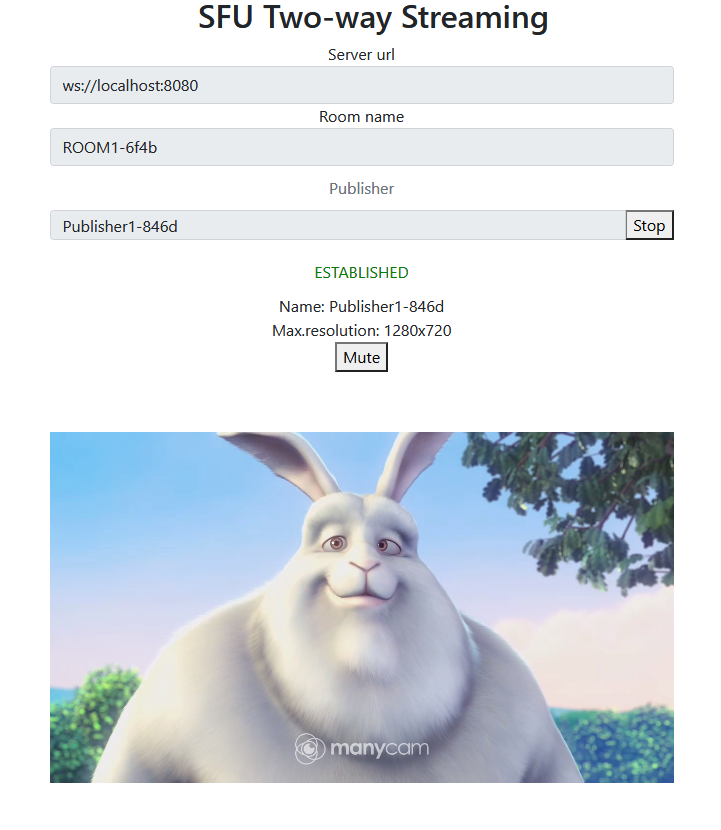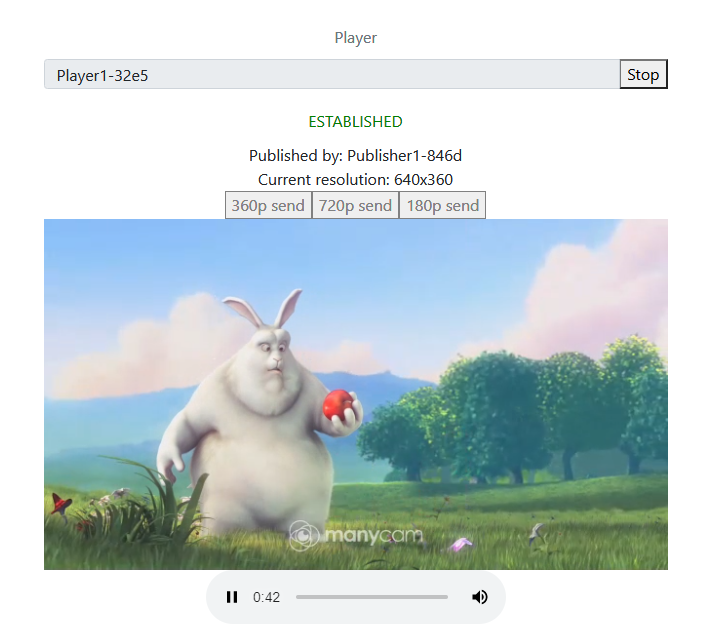The example shows how to publish and play a number of streams in one WebRTC connection with simulcast. A room is considered to be a publishing unit, that is, viewers who connect to this room receive all the streams published in it.
On the screenshots below:
- Server url - Websocket URL of WCS server
- Room name - room name
- Publisher - publisher user name
- Player - viewer user name
- 360p, 720p, 180p send - quality switch buttons
Note that audio tracks are playing in a separate audio tags.
Example source code
The source code consists of the following modules:
- two-way-streaming.html - HTML page
- two-way-streaming.css - HTML page styles
- two-way-streaming.js - main application logic
- config.json - client configuration file, contains streams publishing description
Analyzing the code
To analyze the example source code, take the file two-way-streaming.js version available here
1. Local variables
Local variables declaration to work with constants, SFU SDK, to display video and to work with client configuration
const constants = SFU.constants; const sfu = SFU; let mainConfig; let localDisplay; let remoteDisplay; let publishState; let playState; const PUBLISH = "publish"; const PLAY = "play"; const STOP = "stop"; const PRELOADER_URL="../commons/media/silence.mp3"
2. Default configuration
Default room configuration and stream publishing configuration to use if there is no config.json file found
const defaultConfig = {
room: {
url: "wss://127.0.0.1:8888",
name: "ROOM1",
pin: "1234",
nickName: "User1"
},
media: {
audio: {
tracks: [
{
source: "mic",
channels: 1
}
]
},
video: {
tracks: [
{
source: "camera",
width: 640,
height: 360,
codec: "H264",
encodings: [
{ rid: "360p", active: true, maxBitrate: 500000 },
{ rid: "180p", active: true, maxBitrate: 200000, scaleResolutionDownBy: 2 }
]
}
]
}
}
};
3. Object to store current publishing/playback state
The object should keep Websocket session data, WebRTC connection data and room data, and shoukd form HTML tags ids to access them from code.
const CurrentState = function(prefix) {
let state = {
prefix: prefix,
pc: null,
session: null,
room: null,
timer: null,
set: function(pc, session, room) {
state.pc = pc;
state.session = session;
state.room = room;
},
clear: function() {
state.stopWaiting();
state.room = null;
state.session = null;
state.pc = null;
},
waitFor: function(div, timeout) {
state.stopWaiting();
state.timer = setTimeout(function () {
if (div.innerHTML !== "") {
// Enable stop button
$("#" + state.buttonId()).prop('disabled', false);
}
else if (state.isConnected()) {
setStatus(state.errInfoId(), "No media capturing started in " + timeout + " ms, stopping", "red");
onStopClick(state);
}
}, timeout);
},
stopWaiting: function() {
if (state.timer) {
clearTimeout(state.timer);
state.timer = null;
}
},
buttonId: function() {
return state.prefix + "Btn";
},
buttonText: function() {
return (state.prefix.charAt(0).toUpperCase() + state.prefix.slice(1));
},
inputId: function() {
return state.prefix + "Name";
},
statusId: function() {
return state.prefix + "Status";
},
formId: function() {
return state.prefix + "Form";
},
errInfoId: function() {
return state.prefix + "ErrorInfo";
},
is: function(value) {
return (prefix === value);
},
isActive: function() {
return (state.room && state.pc);
},
isConnected: function() {
return (state.session && state.session.state() == constants.SFU_STATE.CONNECTED);
}
};
return state;
}
4. Initialization
init() code
The init() function is called on page load and:
- initializes state objects
- reads
config.jsonfile or default configuration - initializes input fields
const init = function() {
let configName = getUrlParam("config") || "./config.json";
...
publishState = CurrentState(PUBLISH);
playState = CurrentState(PLAY);
$.getJSON(configName, function(cfg){
mainConfig = cfg;
onDisconnected(publishState);
onDisconnected(playState);
}).fail(function(e){
//use default config
console.error("Error reading configuration file " + configName + ": " + e.status + " " + e.statusText)
console.log("Default config will be used");
mainConfig = defaultConfig;
onDisconnected(publishState);
onDisconnected(playState);
});
$("#url").val(setURL());
$("#roomName").val("ROOM1-"+createUUID(4));
$("#publishName").val("Publisher1-"+createUUID(4));
$("#playName").val("Player1-"+createUUID(4));
}
5. Establishing server connection
connect(), SFU.createRoom() code
The connect() function is called by Publish or Play click:
- creates PeerConnection object
- cleans previous session state displayed
- sets up room configuration and creates Websocket session
- subscribes to Websocket session events
const connect = function(state) {
//create peer connection
pc = new RTCPeerConnection();
//get config object for room creation
const roomConfig = getRoomConfig(mainConfig);
roomConfig.pc = pc;
roomConfig.url = $("#url").val();
roomConfig.roomName = $("#roomName").val();
roomConfig.nickname = $("#" + state.inputId()).val();
// clean state display items
setStatus(state.statusId(), "");
setStatus(state.errInfoId(), "");
// connect to server and create a room if not
const session = sfu.createRoom(roomConfig);
session.on(constants.SFU_EVENT.CONNECTED, function(room) {
state.set(pc, session, room);
onConnected(state);
setStatus(state.statusId(), "ESTABLISHED", "green");
}).on(constants.SFU_EVENT.DISCONNECTED, function() {
state.clear();
onDisconnected(state);
setStatus(state.statusId(), "DISCONNECTED", "green");
}).on(constants.SFU_EVENT.FAILED, function(e) {
state.clear();
onDisconnected(state);
setStatus(state.statusId(), "FAILED", "red");
setStatus(state.errInfoId(), e.status + " " + e.statusText, "red");
});
}
6. Publishing or playback start after session establishing
onConnected() code
The onConnected() function:
- sets up Stop button click actions
- subscribes to room error events
- calls publishing or playback function
const onConnected = function(state) {
$("#" + state.buttonId()).text("Stop").off('click').click(function () {
onStopClick(state);
});
...
// Add errors displaying
state.room.on(constants.SFU_ROOM_EVENT.FAILED, function(e) {
setStatus(state.errInfoId(), e, "red");
stopStreaming(state);
}).on(constants.SFU_ROOM_EVENT.OPERATION_FAILED, function (e) {
setStatus(state.errInfoId(), e.operation + " failed: " + e.error, "red");
stopStreaming(state);
});
startStreaming(state);
}
7. Streams publishing
publishStreams(), SFURoom.join() code
The publishStreams() function:
- initializes a basic HTML container tag to display local video
- gets local media access accorging to configuration file
- adds media tracks to WEbRTC connection
- joins the room on server
- starts a timer to wait for successful local video tags initializaton
const publishStreams = async function(state) {
if (state.isConnected()) {
//create local display item to show local streams
localDisplay = initLocalDisplay(document.getElementById("localVideo"));
try {
//get configured local video streams
let streams = await getVideoStreams(mainConfig);
let audioStreams = await getAudioStreams(mainConfig);
if (state.isConnected() && state.isActive()) {
//combine local video streams with audio streams
streams.push.apply(streams, audioStreams);
let config = {};
//add our local streams to the room (to PeerConnection)
streams.forEach(function (s) {
//add local stream to local display
localDisplay.add(s.stream.id, $("#" + state.inputId()).val(), s.stream);
//add each track to PeerConnection
s.stream.getTracks().forEach((track) => {
if (s.source === "screen") {
config[track.id] = s.source;
}
addTrackToPeerConnection(state.pc, s.stream, track, s.encodings);
subscribeTrackToEndedEvent(state.room, track, state.pc);
});
});
state.room.join(config);
// TODO: Use room state or promises to detect if publishing started to enable stop button
state.waitFor(document.getElementById("localVideo"), 3000);
}
} catch(e) {
console.error("Failed to capture streams: " + e);
setStatus(state.errInfoId(), e.name, "red");
state.stopWaiting();
if (state.isConnected()) {
onStopClick(state);
}
}
}
}
7.1. Media tracks addition to WebRTC connection
addTrackToPeerConnection(), PeerConnection.addTransceiver() code
const addTrackToPeerConnection = function(pc, stream, track, encodings) {
pc.addTransceiver(track, {
direction: "sendonly",
streams: [stream],
sendEncodings: encodings ? encodings : [] //passing encoding types for video simulcast tracks
});
}
7.2. Tracks onended event subscription
subscribeTrackToEndedEvent(), MediaTrack.addEventListener(), SFURoom.updateState() code
const subscribeTrackToEndedEvent = function(room, track, pc) {
track.addEventListener("ended", function() {
//track ended, see if we need to cleanup
let negotiate = false;
for (const sender of pc.getSenders()) {
if (sender.track === track) {
pc.removeTrack(sender);
//track found, set renegotiation flag
negotiate = true;
break;
}
}
if (negotiate) {
//kickoff renegotiation
room.updateState();
}
});
};
8. Streams playback
playStreams(), SFURoom.join() code
The playStreams() function:
- initializes a base container tag to display incoming media streams
- joins to the room on server
const playStreams = function(state) {
if (state.isConnected() && state.isActive()) {
//create remote display item to show remote streams
remoteDisplay = initRemoteDisplay({
div: document.getElementById("remoteVideo"),
room: state.room,
peerConnection: state.pc
});
state.room.join(state.pc);
}
$("#" + state.buttonId()).prop('disabled', false);
}
9. Publishing stopping
unPublishStreams(), localDisplay.stop() code
const unPublishStreams = function(state) {
if (localDisplay) {
localDisplay.stop();
}
}
10. Playback stopping
stopStreams(), remoteDisplay.stop() code
const stopStreams = function(state) {
if (remoteDisplay) {
remoteDisplay.stop();
}
}
11. Publish/Play click action
onStartClick(), playFirstSound(), connect() code
The onStartClick() function:
- validates input fields
- in Safari browser, calls playFirstSound() before playback to automatically play incoming audio
- calls connect() function
const onStartClick = function(state) {
if (validateForm("connectionForm") && validateForm(state.formId())) {
$("#" + state.buttonId()).prop('disabled', true);
if (state.is(PLAY) && Browser().isSafariWebRTC()) {
playFirstSound(document.getElementById("main"), PRELOADER_URL).then(function () {
connect(state);
});
} else {
connect(state);
}
}
}
12. Stop click actions
onStopClick(), Session.disconnect() code
The onStopClick() function:
- stops playback or publishing
- disconects Websocket session
const onStopClick = function(state) {
$("#" + state.buttonId()).prop('disabled', true);
stopStreaming(state);
if (state.isConnected()) {
state.session.disconnect();
}
}
13. Websocket session disconnection actions
onDisconnected() code
The onDisconnected() functions:
- sets up Publish/Play click actions
- enables Server url and Room name fields access, if there's no parallel session
const onDisconnected = function(state) {
$("#" + state.buttonId()).text(state.buttonText()).off('click').click(function () {
onStartClick(state);
}).prop('disabled', false);
$("#" + state.inputId()).prop('disabled', false);
// Check if other session is active
if ((state.is(PUBLISH) && playState.session)
|| (state.is(PLAY) && publishState.session)) {
return;
}
$('#url').prop('disabled', false);
$("#roomName").prop('disabled', false);
}
14. Helper functions
14.1. Start publishing or playback
startStreaming() code
const startStreaming = function(state) {
if (state.is(PUBLISH)) {
publishStreams(state);
} else if (state.is(PLAY)) {
playStreams(state);
}
}
14.2. Stop publishing or playback
stopStreaming() code
const stopStreaming = function(state) {
state.stopWaiting();
if (state.is(PUBLISH)) {
unPublishStreams(state);
} else if (state.is(PLAY)) {
stopStreams(state);
}
}

